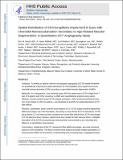SPATIAL DISTRIBUTION OF CHORIOCAPILLARIS IMPAIRMENT IN EYES WITH CHOROIDAL NEOVASCULARIZATION SECONDARY TO AGE-RELATED MACULAR DEGENERATION: A Quantitative OCT Angiography Study
Author(s)
Moult, Eric M; Alibhai, Agha Yasin; Rebhun, Carl; Lee, ByungKun; Ploner, Stefan; Schottenhamml, Julia; Husvogt, Lennart; Baumal, Caroline R; Witkin, Andre J; Maier, Andreas; Duker, Jay S; Rosenfeld, Phillip J; Waheed, Nadia K; Fujimoto, James G; ... Show more Show less
DownloadAccepted version (6.426Mb)
Open Access Policy
Open Access Policy
Creative Commons Attribution-Noncommercial-Share Alike
Terms of use
Metadata
Show full item recordAbstract
PURPOSE: To develop an optical coherence tomography angiography (OCTA)-based framework for quantitatively analyzing the spatial distribution of choriocapillaris (CC) impairment around choroidal neovascularization (CNV) secondary to age-related macular degeneration. METHODS: In a retrospective, cross-sectional study, 400-kHz swept-source OCTA images from 7 eyes of 6 patients with CNV secondary to age-related macular degeneration were quantitatively analyzed using custom software. A lesion-centered zonal OCTA analysis technique-which portioned the field-of-view into zones relative to CNV boundaries-was developed to quantify the spatial dependence of CC flow deficits. RESULTS: Quantitative, lesion-centered zonal analysis of CC OCTA images revealed highest flow-deficit percentages near CNV boundaries, decreasing in zones farther from the boundaries. Optical coherence tomography angiography using shorter (1.5 ms) interscan times revealed more severe flow deficits than OCTA using longer (3.0 ms) interscan times; however, spatial trends were similar for both interscan times. A detailed description of the OCTA processing steps and parameters was provided so as to elucidate their influence on quantitative measurements. CONCLUSION: Impairment of the CC, assessed by flow-deficit percentages, was most prominent closest to CNV boundaries. The lesion-centered zonal analysis technique enabled quantitative CC measurements relative to focal lesions. Understanding how processing steps, imaging/processing parameters, and artifacts can affect quantitative CC measurements is important for longitudinal, OCTA-based studies of disease progression, and treatment response.
Date issued
2020Department
Massachusetts Institute of Technology. Department of Electrical Engineering and Computer Science; Massachusetts Institute of Technology. Research Laboratory of ElectronicsJournal
Retina
Publisher
Ovid Technologies (Wolters Kluwer Health)